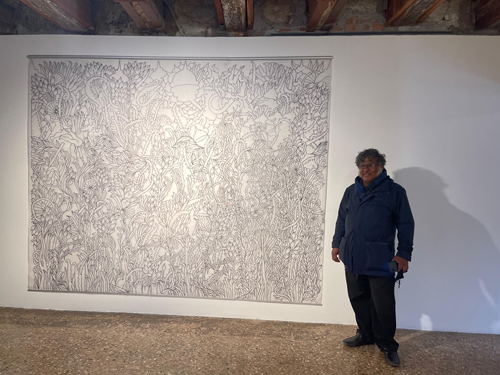‘I am first an activist, then an artist’

‘Covert’: Thenuwara with his installation made of wire at the Venice Biennale
It is only the third time a Sri Lankan artist is featured at the prestigious Venice Biennale, and this time the honour goes to renowned artist Chandraguptha Thenuwara who will represent the country with his installation as part of the ‘Personal Structures’ Exhibition presented by the European Cultural Centre (ECC) Venice.
The Venice Biennale 2022, an international contemporary art exhibition held biennially in Italy opened on April 23 and continues for seven months concluding on November 27. Since 2011 the ECC has featured artists that break away from any ideological, political and geographical barriers and this year has 192 artists from 51 countries whose work will be presented at three historical Venetian venues – the Palazzo Bembo, Palazzo Mora and Marinaressa Gardens, in the heart of the city.
“My works are a response to my social, cultural and political surroundings,” says Thenuwara whose sculpture for the Venice Biennale titled ‘Covert’ is an installation described as ‘an infinite vortex of interlocking motifs constructed out of wire which link and fuse together’.
Thenuwara told the Sunday Times that he was prompted by his inspiration to critique the use of religious extremism and militarisation by officials to enter into power. Among the representative images he has utilised in this installation is the lotus: “This innocent symbol that belonged to a personal space was used by politicians for their political gain. It was once a white lotus representing peace but this lotus that I incorporate in my work is a symbol of power.”
The installation shows four hidden figures of soldiers bearing weapons and standing to attention while saluting — the barbed wire is used in reference to the latter stages of the conflict in 2009. “The barbwire and divisions have been there for so long that it has become confused with thorns in nature: natural barriers. This work symbolises my critique of the war and continued marginalisation of non-Sinhala Buddhist communities, representing a range of unresolved grievance.”
The central theme of the Venice Biennale this year is that of reflections, specifically “which embodies the dual meaning of a visible episode perceived by the eyes and a mental deed stemming from the action of thinking and pondering with the mind”. Thenuwara shares that he commenced work on ‘Covert’ last year and began to construct the installation in February this year adding that his work was impacted by the current situation prevailing in the country. “My works are essentially a reflection of what is happening locally. I am after all, first and foremost an activist.”
Speaking on the potential of art to enact social change, Thenuwara referred again to the current crisis saying, “Look at Galle Face. It is the people’s art. It is a performance for greater change. They are suffering but they are singing, performing theatre and shouting; all of these are a form of artistic expression. Projections on building, visual messages; this is all contemporary art. The symbolism they are carrying are made by artists; when there is something happening via change it is better to speak through art rather than using ‘political’ language, and that is why politicians are afraid of art. Sometimes people too are afraid of art because of its power. As Joseph Beuys says; ‘Every man[woman] is an artist’.”
As a gallery artist of the Saskia Fernando Gallery where much of his work has been exhibited throughout his career, Thenuwara says that his relationship with the gallery is ‘also a political act’. “This is a local gallery immersed in Sri Lanka’s political culture and its politics and I believe this relationship is very important.” Also being featured this year in the Venice Biennale and represented by the Saskia Fernando Gallery is Belgian artist Saskia Pintelon who has made her home in Sri Lanka.
During his decades-long career, Thenuwara who hails from Galle, has gained attention for portraying contemporary events through symbolism and ideas that deal with the political landscape of the country, human rights, conflict and hardship. In 1997, the artist began presenting his self-curated memorial exhibitions, held annually on the 23rd of July to memorialize the ‘Black July’ riots of 1983. The shows began with a series dubbed ‘Barrelism’, which included a number of works where Thenuwara depicted the increasing militarization in the country with a series of barrels in various mediums, which were seen at barricades and checkpoints throughout the country.
Thenuwara first studied painting at the Institute of Aesthetic Studies, University of Kelaniya before leaving for further studies at the Surikov State Art Institute, Moscow, Russia. He followed this with an MPhil at the Post Graduate Institute of Archaeology (PGIAR), Kelaniya University in 2006. In 1993, he founded the Vibhavi Academy of Fine Arts (VAFA), an artist-run alternative art school. He is currently a Professor of the Department of History and Art Theory at the University of the Visual and Performing Arts and director of the Internal Quality Assurance Unit of the University of the Visual and Performing Arts, Colombo.
Thenuwara’s work has been exhibited locally and internationally since 1978 and can be found in the collections of the Queensland Art Gallery Australia, Fukuoka Asian Art Museum Japan, John Moore’s University Art Collection Liverpool and Fine Arts Museum of Udmurtia, Izhevsk, Russia. He has also created public monuments such as the Seeduwa monument to the Disappeared and Monument to Neelan Thiruchelvam at Kynsey Terrace, Colombo.
Thenuwara’s installation is at the European Cultural Centre – Palazzo Mora, Strada Nova, Venice.
Searching for an ideal partner? Find your soul mate on Hitad.lk, Sri Lanka's favourite marriage proposals page. With Hitad.lk matrimonial advertisements you have access to thousands of ads from potential suitors who are looking for someone just like you.


